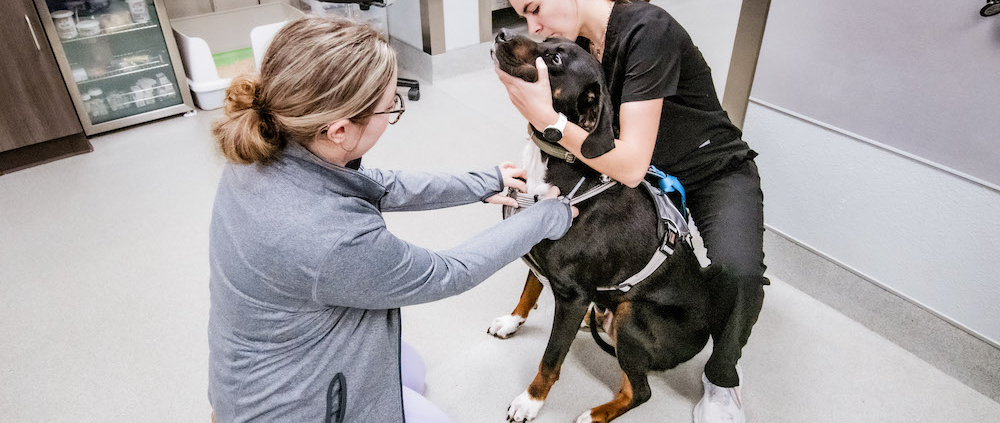Dog Collapsed: Causes, What to Do in This Emergency
The first time I saw my dog collapse, it was one of the scariest moments of my life. Saying my heart almost stopped would be an understatement – there’s just no way to fully describe that feeling. The best thing you can do in that moment, however, is to stay calm, act fast, and pay attention.
The second-best thing? Tell me how you did pull it off – because it will be stressful, and it will be scary.
Hopefully, if I can teach you what to look for, you’ll remember the three things that matter most:
- Assess the situation
- Provide immediate care
- Get to your vet ASAP
I want to remind you, sometimes fainting or collapsing can be harmless, but it can also be a sign of something serious.
Step 1: Assess the Situation
What we’re looking for here is an “understanding” of what we’re dealing with. We start off with the basics:
- Check for responsiveness: Pet or Human, we always start by calling their name, touch them gently. Do they respond? We want to see if they’re responding. The main thing we’re looking for here is whether or not they fainted, if they had a seizure, or if it’s something else entirely. Is their brain “okay” for lack of better terms.
- Check their breathing: Watch their chest. Is it moving? Basically, are they breathing? And if they are, does it look normal? shallow? strained? That tells you how urgent it is to get them oxygen or to the vet.
- Look for injuries: Any bleeding, swelling, or signs they might’ve hurt themselves when they went down? This one is going to depend on your knowledge. What were they doing before they collapsed? Were they running?
- Look at your surroundings: Take in the whole scene. Is there blood anywhere nearby? Could there be something dangerous around? We’re looking for snakes, sharp objects, or spilled chemicals? And don’t forget to check the weather – if your dog was running around in 105° heat, they might be overheating. Look at their tongue – is it swollen or bright red? These small details can give you big clues about what caused the collapse.
Step 2: Provide Immediate Care
Once you’ve checked the basics, it’s time to act. What you do in the next minute or two can make a big difference. We’re working with short windows here – call us in an emergency and we can walk you through what to do as you drive to our location. The message I need you to understand is that you can’t wait. Sometimes fainting is harmless, but like I mentioned above, it can be a sign of something serious.
- If they’re not breathing: Clear their airway if you can, see if there are any obstructions like a rock or a stick, and head straight to your vet or the nearest emergency clinic.
- If they’re unconscious but breathing: Gently lay them on their side, keep their airway clear, and watch their chest for movement. Keep talking to them – your voice helps. We’re looking for breathing and heart beats (a pulse).
- If there’s bleeding: Use a clean towel or cloth and apply steady, gentle pressure. Don’t press too hard – just enough to slow or stop the bleeding, then head to the pet hospital.
- If it’s cold outside: Wrap them in a blanket to help them keep their body temperature up while you get ready to move them.
The goal here isn’t to fix the problem on your own, the goal is to keep your dog safe and stable until you reach the professionals who can help them.
Step 3: Get to Your Veterinarian
Once you’ve done what you can at home, the next step is getting your dog to the vet as soon as possible. Collapsing can happen for several reasons, so you need to bring them to us as fast as possible. When they’re here, here’s what we’ll be looking for when you arrive:
- Heart issues: When the heart isn’t pumping enough oxygen to the brain, your dog can faint.
- Breathing problems: Difficulty getting enough oxygen can quickly cause collapse.
- Neurological issues: Things like seizures, strokes, or nerve problems.
- Trauma: A hard fall or accident can send their body into shock.
- Toxins: Eating something poisonous can cause sudden collapse.
- Severe infections: Illness can quickly overwhelm their little bodies and weakness can hit fast.
Our entire goal when you’re dog is under our care is to get them to be stable and breathing comfortably. Once that’s under control, some of the tests we’ll do are:
- Bloodwork and urinalysis to check organ function and hydration.
- X-rays or ultrasound to look for internal injuries or abnormalities.
- ECG (heart scan) to check heart rhythm and strength.
- Neurological exam if it looks like a seizure or nerve issue.
Whatever treatment we end up providing you will heavily depend on the cause. It might be medication, oxygen, IV fluids, or surgery in more severe cases.
What matters most is getting your dog seen quickly. Early action can make all the difference.



